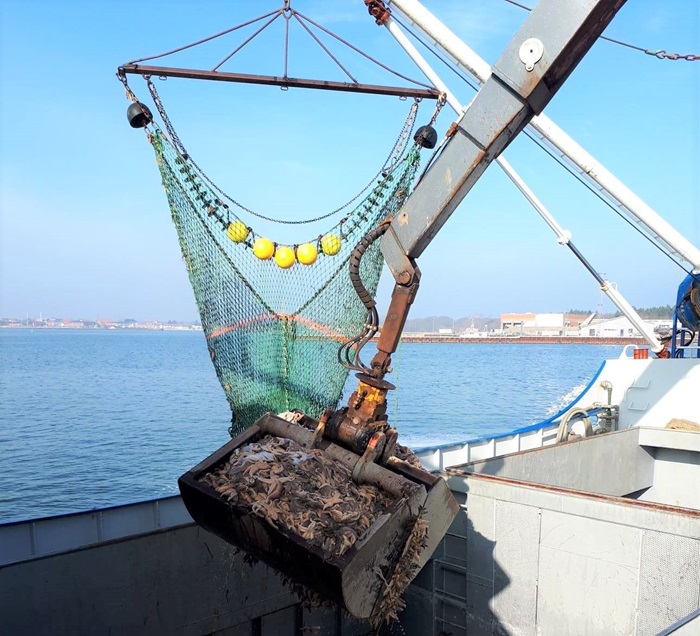The world’s first starfish meal factory will be inaugurated at the Limfjord on Friday, 29 March as a result of collaboration between universities and businesses.
Up to 50 starfish per square metre. This is the situation in several places in the Limfjord, where the large stocks have been a problem for mussel fishermen for many years. The starfish eat large quantities of mussels and oysters and are thus a direct mussel fishery competitor.
But now the excessive stocks of starfish in the Limfjord are being transformed from a threat to mussel fishery into being a brand-new sustainable product. This transformation is the result of four years of wide collaboration between researchers, fishermen, and business owners in the STARPRO project, with funding from the Ministry of Environment and Food of Denmark’s Green Development and Demonstration Programme GUDP.
“When a dense shoal of starfish pass over a mussel bed, they can devour the entire bed in an amazingly short period of time. But now universities, fishermen, and animal feed producers have together created a basis for making starfish meal part of organic livestock production,” says Professor Jens Kjerulf Petersen, DTU Aqua, who is also project manager of STARPRO.

Starfish are scooped up by a fishing boat with starfish seine in the background. Photo: Danish Shellfish Centre.
Catch without use is simply a waste disposal problem
In collaboration with the Danish Mussel Fishery Association and fishermen, the Danish Shellfish Centre at DTU Aqua has developed a gentle tool which catches starfish very cleanly and with low environmental impact. But only now when there is a factory that can use the caught starfish will it be realistic to initiate starfish fishery. Otherwise, there would simply be a waste disposal problem.
In 2015, GUDP therefore funded the STARPRO project, the object of which was to create a basis for and initiate permanent starfish fishery aimed at turning starfish into starfish meal as a feed ingredient. In addition to the Danish Shellfish Centre and the Mussel Fishery Association, the project had participation by Aarhus University and a feedstuff producer, and the aim was to cover the entire process from fishing to finished product:
• To establish knowledge of the biological basis for a starfish fishery in the form of possible volumes of catches and optimal fishing seasons.
• To find cost-effective processing methods for both processing and drying.
• To test the quality of starfish meal as an animal feed ingredient for piglets and poultry, including different feed mixtures.
Now Vestjyllands Andel and Danish Marine Protein can inaugurate a starfish factory in Kaastrup near Skive on 29 March 2019. Thus realizing the ultimate dream scenario for STARPRO.
"A new and gentle fishery has been created, which even has positive side effects on the mussel fishery industry. The protein source that starfish constitute is a brand-new and fully useable feed ingredient in—for example—organic livestock production, and new jobs have been created. The investments come from enterprises which see a potential in the results, and—in applied research—an end product like this is very close to being a dream scenario,” says Jens Kjerulf Petersen.

Starfish ready for processing, photo: Danish Shellfish Centre.
Experience may pave the way for trials with other protein sources
The most important challenges in the project have not been of either a technical or a biological nature. Because no one in the EU had imagined that starfish could be a feed ingredient, they did not appear on the necessary lists of approved organisms and were therefore—by definition—not permitted. However, diligent and unique collaboration between the Ministry of Environment and Food of Denmark, the project, and Danish EU parliamentarians paved the way for starfish to be entered on the lists, and starfish have now been approved as a feed ingredient.
In addition to the specific results, the STARPRO project holds wider perspectives. New and sustainable marine protein sources have been put on the agenda in a tangible manner. With the Kaastrup factory, there is a real and down-to-earth base for testing other marine protein sources as feed ingredients, for example seaweed and fish offcuts.
“It has been very encouraging to see how a problem—the starfish—has been turned into a resource. It’s a perspective we can use for other challenges in our coastal waters, for example for invasive species like Pacific oysters,” says Jens Kjerulf Petersen.